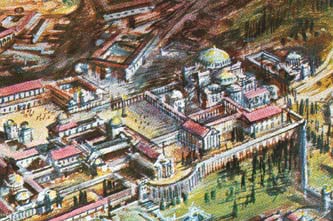 Contents -
Previous Article -
Next Article
Contents -
Previous Article -
Next Article
Constantine's new Christian capital took over five years to build. It had some of the strongest walls of any city in the world, many public baths, two senate houses, wide streets, and many beautiful public buildings. It was situated at a military crossroads between East and West, Europe and Asia. Constantinople was also ideally located to control and profit from any water-borne trade that passed between the Black Sea and the Mediterranean. Eastern Roman and later Byzantine merchants became immensely wealthy from trading with all nations from the farthest corners of the globe. Silks, gold, salt, slaves, grain to feed her multitudes, gemstones, spices, amber, furs, papyrus, pilgrims visiting the holy sites, and travelers from a hundred nations and tribes passed through the gates of Constantinople. Kings of mighty nations and warlords of remote barbarian tribes stood gazing in awe at the riches and opulence of this city, or camped outside her gates, hoping to seize her treasures by force. But so well defended and prepared for any kind of siege was Constantinople that she dodn’t fall to any invading army until 1453, when the Ottoman Turks dismantled the sad remains of the Byzantine Empire, by then merely a hollow parody of the greatness of bygone days. The modern, efficient Byzantine Navy and a triple wall on the landward side built by the Roman emperor Theodosius II in the first half of the Fifth Century A. D. helped to make this fortress-city virtually impregnable and invulnerable to direct military attack, though the city fell to treachery from within her own walls several times during the 1100 years as capital of the Eastern Roman Empire.
The image at the top right corner of this page is the emperor's palace at Constantinople from an illustration that shows how the city was probably laid out during the Eleventh Century.
Go to next article:
Go back to previous article: